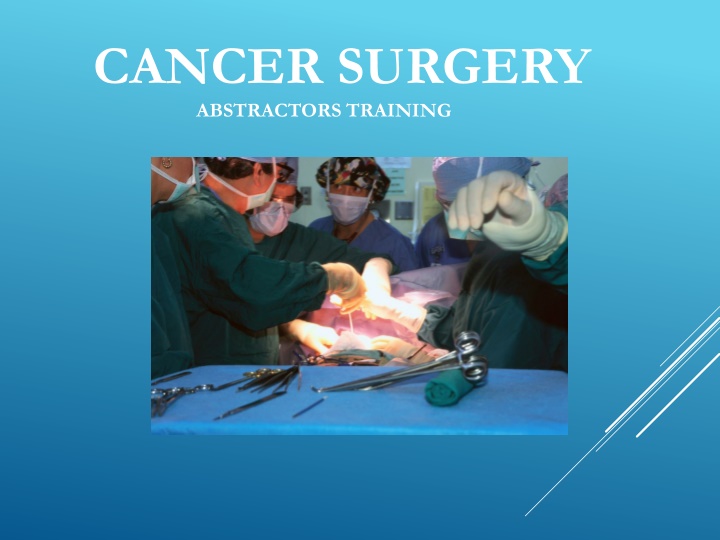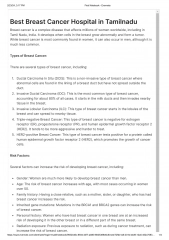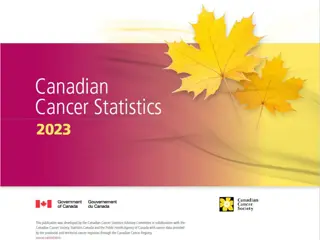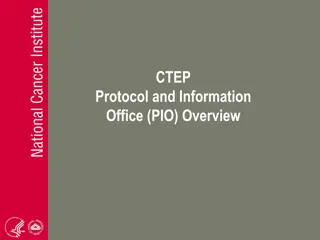CANCER SURGERY
Many types of cancer can be treated through surgical removal, with procedures tailored to factors like cancer type, stage, and patient's condition. Biopsies play a crucial role in diagnosing the tumor type, distinguishing between definitive and non-definitive surgeries, each with specific coding guidelines.
Download Presentation

Please find below an Image/Link to download the presentation.
The content on the website is provided AS IS for your information and personal use only. It may not be sold, licensed, or shared on other websites without obtaining consent from the author.If you encounter any issues during the download, it is possible that the publisher has removed the file from their server.
You are allowed to download the files provided on this website for personal or commercial use, subject to the condition that they are used lawfully. All files are the property of their respective owners.
The content on the website is provided AS IS for your information and personal use only. It may not be sold, licensed, or shared on other websites without obtaining consent from the author.
E N D
Presentation Transcript
CANCER SURGERY ABSTRACTORS TRAINING
CANCER SURGERY Many types of cancer can be partially or totally removed from the human body by means of surgical treatment. The type of surgery is dictated by the primary site, type of cancer, clinical stage of disease, age/condition of patient, & so on .
OBTAINING THE DIAGNOSIS: Most cancers are first biopsied in order to determine tumor type. Incisional biopsies extract small portions of tumor for microscopic examination. Excisional biopsies remove the tumor mass as a whole.
NON-DEFINITIVE SURGERY Create N for coding incisional biopsies that produce malignant tissue. Additional non-definitive surgery descriptions are shown on the following slide.
Non-Definitive Surgery Codes 01Incisional biopsy of other than primary site leaving gross residual disease. Needle biopsy of other than primary site. Aspiration biopsy of other than primary site. 02 Incisional biopsy of primary site leaving gross residual disease. Needle biopsy of primary site. Aspiration biopsy of primary site (must obtain tissue to be recorded). 03 Exploratory ONLY (no biopsy)
NON-DEFINITIVE SURGERY CODES (CONT D) 04Bypass surgery (no biopsy); - ostomy ONLY (no biopsy) 05 Exploratory ONLY & incisional or needle biopsy of primary site or other sites 06 Bypass surgery & incisional or needle biopsy of primary site or other sites, ostomy ONLY, & incisional or needle biopsy of primary site or other sites 07 Non-definitive surgery, NOS
DO NOT CREATE N FOR: Cytology results only, such as from: Fine needle aspirations Brushings & washings from bronchoscopy Peripheral blood smears Regional lymph node aspirations Excisional biopsies Incisional biopsies with negative results
RULE FOR RECORDING NON-DEFINITIVE BIOPSY WHEN MORE THAN ONE BIOPSY IS PERFORMED: Record the first positive, non-definitive tissue biopsy. If a positive biopsy is performed from both the primary site and a metastatic/non- primary site, record the biopsy from the primary site. Do not record negative biopsies.
N TREATMENT FIELDS Type of Tx Course of Tx Date Tx started 03/15/09 Tx facility Tx at this facility? 0 Tx code Tx text N F 510375 02 Sigmoid bx
DEFINITIVE SURGICAL THERAPY Create S for all definitive cancer surgeries. Definitive surgeries remove malignant tumors, although margins may not be negative. Excisional biopsy is one example of definitive surgery.
SURGERY TREATMENT FIELDS Tx Type Tx Course Date Tx Started Tx Facility Tx Local Hosp ID Surgery Primary Site (FORDS) Scope Regional LN (FORDS) Surgery Other Site (FORDS) Surgical Margins (FORDS) Tx Notes S F 03/15/2009
COURSE OF TREATMENT First course = F Subsequent course = S
DATE OF SURGERY Carefully code the exact date on which the first course surgery took place. On path reports, this is often the same as the date the specimen was received by the lab (may also be date collected).
TREATMENT FACILITY Enter the facility name or code where the surgery took place. (See Appendix F of CPDMS abstractor s manual.)
TREATMENT LOCAL HOSPITAL ID Enter code indicating whether or not this surgery was performed at YOUR facility. 0 = Not at your facility Hosp ID = Hospital name 9 = Valid for diagnoses BEFORE 1/1/03 only.
SURGICAL PROCEDURE OF PRIMARY SITE Site-specific codes located in Appendix G of CPDMS Abstractor s Manual & Appendix B of FORDS Manual. Most common codes range from 00 to 79 . Codes 80 and 90 are only rarely used when precise information is unavailable. Bx s that remove all tumor or leave microscopic margins are coded here even if documented as incisional bx s. When previous surgery removes part of primary tumor & additional surgery removes remainder of primary tumor, code total results .
SURGERY PRIMARY SITE Colon Rectosigmoid Rectum Anus
COLON (C18.0-C18.9) 00 No surgery of primary; autopsy only Local tumor destruction, NOS 11 Photodynamic therapy (PDT) 12 Electrocautery; fulguration 13 Cryosurgery 14 Laser NO SPECIMEN SENT TO PATHOLOGY from surgical events 10-14 10
COLON (CONTD) 20 Local tumor excision, NOS 27 Excisional biopsy 26 Polypectomy, NOS 28 Polypectomy endoscopic 29 Polypectomy surgical excision Any combination of 20 or 26-29 WITH 21 Photodynamic therapy (PDT) 22 Electrocautery; fulguration 23 Cryosurgery 24 Laser ablation 25 Laser excision
COLON (CONTD) 30 Partial colectomy, segmental resection 32 Plus resection of contiguous organs; example: small bowel, bladder Subtotal colectomy/hemicolectomy (total right or left colon and a portion of transverse colon) 41 Plus resection of contiguous organ; example: small bowel, bladder Total colectomy (removal of colon from cecum to the rectosigmoid junction; may include a portion of rectum) 51 Plus resection of contiguous organ; example: small bowel, bladder 40 50
COLON (CONTD) 60 Total proctocolectomy (removal from cecum to entire rectum) 61 Plus resection of contiguous organ; example: small bowel, bladder Colectomy or coloproctotectomy WITH resection of contiguous organ(s), NOS (where there is not enough information to code 32, 41, 51, or 61) 80 Colectomy, NOS 90 Surgery, NOS 99 Unknown if surgery performed; death certificate ONLY 70
COLON CODING PRACTICE Pt underwent colonoscopy with polypectomy & was diagnosed with atubular adenoma containing microinvasive adenocarcinoma. Margins clear. Surgery code? 1. Pt underwent sigmoidectomy for mucinous adenocarcinoma of sigmoid colon. Surgery code? 2.
RECTOSIGMOID (C19.9) 00 No surgery of primary; autopsy only Local tumor destruction, NOS 11 Photodynamic therapy (PDT) 12 Electrocautery; fulguration 13 Cryosurgery 14 Laser NO SPECIMEN SENT TO PATHOLOGY from surgical events 10-14 10
RECTOSIGMOID (CONTD) 20 Local tumor excision, NOS 26 Polypectomy 27 Excisional biopsy Any combination of 20 or 26-27 WITH 21 Photodynamic therapy (PDT) 22 Electrocautery; fulguration 23 Cryosurgery 24 Laser ablation 25 Laser excision
RECTOSIGMOID (CONTD) Wedge or segmental resection; partial proctosigmoidectomy, NOS Procedures coded 30 include, but are not limited to: Anterior resection Hartmann s Operation Low anterior resection (LAR) Partial colectomy, NOS Rectosigmoidectomy, NOS Sigmoidectomy Pull through WITH sphincter preservation (coloanal anastamosis 30 40
50 Total proctectomy 51 Total colectomy 55 Total colectomy WITH ileostomy, NOS 56 Ileorectal reconstruction 57 Total colectomy WITH other pouch; example: Koch pouch 60 Total proctocolectomy, NOS 65 Total proctocolectomy WITH ileostomy, NOS 66 Total proctocolectomy WITH ileostomy and pouch Removal of the colon from the cecum to the rectal sigmoid or a portion of the rectum. RECTOSIGMOID (CONT D)
RECTOSIGMOID (CONTD) Colectomy or proctocolectomy resection in continuity with other organs; pelvic exenteration Colectomy, NOS; proctectomy, NOS Surgery, NOS Unknown if surgery performed; death certificate only 70 80 90 99
RECTOSIGMOID CODING PRACTICE Pt chose to undergo low anterior resection of sigmoid colon for adenocarcinoma. Surgery code? 1. Total proctectomy was the treatment selected for adenocarcinoma of the sigmoid colon. Surgery code? 2.
RECTUM (C20.9) 00 No surgery of primary; autopsy only Local tumor destruction, NOS 11 Photodynamic therapy (PDT) 12 Electrocautery; fulguration 13 Cryosurgery 14 Laser NO SPECIMEN SENT TO PATHOLOGY from surgical events 10-14 10
RECTUM (CONTD) 20 Local tumor excision, NOS 27 Excisional biopsy 26 Polypectomy Any combination of 20 or 26-27 WITH 21 Photodynamic therapy (PDT) 22 Electrocautery; fulguration 23 Cryosurgery 24 Laser ablation 25 Laser excision 28 Curette and fulguration
RECTUM (CONTD) Wedge or segmental resection; partial proctectomy, NOS Procedures coded 30 include, but are not limited to: Anterior resection Hartmann s Operation Low anterior resection (LAR) Transsacral rectosigmoidectomy Total mesorectal excision (TME) Pull through WITH sphincter preservation (coloanal anastamosis 30 40
RECTUM (CONTD) Total proctectomy Code 50 includes, but is not limited to: Abdominoperineal resection (Miles procedure AKA APR) Total proctocolectomy, NOS Proctectomy or proctocolectomy resection in continuity with other organs; pelvic exenteration Proctectomy, NOS Surgery, NOS Unknown if surgery performed; death certificate only 50 60 70 80 90 99
RECTUM CODING PRACTICE Pt underwent APR of adenocarcinoma of rectum. Surgery code? 1. 2. Pt underwent polypectomy with fulguration for adenocarcinoma in situ arising in a polyp. Margins clear on pathology report. Surgery code?
ANUS (C21.0-C21.8) 00 No surgery of primary; autopsy only Local tumor destruction, NOS 11 Photodynamic therapy (PDT) 12 Electrocautery; fulguration 13 Cryosurgery 14 Laser 15 Thermal ablation NO SPECIMEN SENT TO PATHOLOGY from surgical events 10-15 10
ANUS (CONTD) 20 Local tumor excision, NOS 26 Polypectomy 27 Excisional biopsy Any combination of 20 or 26-27 WITH 21 Photodynamic therapy (PDT) 22 Electrocautery; fulguration 23 Cryosurgery 24 Laser ablation 25 Laser excision
ANUS (CONTD) 60 Abdominal perineal resection, NOS (APR; Miles Miles procedure) 61 APR and sentinel node excision 62 APR and unilateral inguinal node dissection 63 APR and bilateral inguinal node dissection Surgery, NOS 99 Unknown if surgery performed; death certificate ONLY 90
ANUS CODING PRACTICE Elderly male with change in bowel movements and blood from rectum underwent transanal excsion of a superficial anal mass. Pathology reported adenocarcinoma in situ. Surgery code? 1. 59 y/o male with biopsy-proven rectal adenocarcinoma chose to undergo APR and sentinel node biopsy. Surgery code? 2.
Remaining Surgery Fields All Sites
SURGICAL APPROACH Record the surgical method used to approach the primary site at this facility.
SURGICAL APPROACH CODES 0 No surgical procedure of primary site at this facility; diagnosed at autopsy Robotic assisted Robotic converted to open Endoscopic Endoscopic converted to open Open or approach unspecified Unknown whether surgery was performed at this facility 1 2 3 4 5 6
SCOPE OF REGIONAL LN SURGERY Record the removal, biopsy, or aspiration of regional lymph node(s) at the time of surgery of the primary site or during a separate surgical event.
SCOPE OF REGIONAL LN SURGERY Codes: 0 No regional lymph node surgery; no lymph nodes found in the pathologic specimen; or diagnosed at autopsy 1 Biopsy or aspiration of regional lymph node(s) 2 Sentinel lymph node biopsy; attempted sentinel lymph node biopsy Number of regional nodes removed unknown or not stated; not specified as sentinel nodes 4 1-3 regional nodes removed; not specified as sentinel nodes 3
SCOPE OF REGIONAL LN SURGERY Codes (cont d): 4 or more regional nodes removed; not specified as sentinel nodes Sentinel node biopsy performed OR attempted AND code 3, 4, or 5 performed at same time, or timing not specified Sentinel node biopsy performed OR attempted AND code 3, 4, or 5 at different times 9 Unknown whether regional nodes removed; death certificate-only; lymphomas with LN as primary site; hematopoietic diseases; unknown primary 5 6 7
SURGICAL PROCEDURE/ OTHER SITE Record the surgical removal of distant lymph nodes or other tissue(s)/organ(s) beyond the primary site.
SURGICAL PROCEDURE/ OTHER SITE Codes: 0 No surgical procedure of nonprimary site performed; diagnosed at autopsy 1 Nonprimary surgical resection to other site(s), unknown whether site(s) regional OR distant. 2 Nonprimary surgical procedure to other regional sites 3 Nonprimary surgical procedure to distant lymph node(s) 4 Nonprimary surgical procedure to distant site 5 Any combination of surgical procedures 2, 3, or 4 9 Unknown; death certificate only
SURGICAL MARGINS Describes status of surgical margins after resection of primary tumor. Microscopic can t be seen with naked eye. Macroscopic can be seen with naked eye. Must code this data item from pathology reports. Carefully check path reports for statement of margin status.
SURGICAL MARGINS CODES Codes: 0 No residual tumor 1 Residual tumor, NOS 2 Microscopic residual tumor 3 Macroscopic residual tumor 7 Margins not evaluable 8 No primary site surgery 9 Unknown or not applicable
TREATMENT NOTES Type in treatment descriptions using accepted abbreviations (Appendix H). Can show additional information, such as estimated date , in this field. If complete treatment information is documented in this field, you don t have to repeat the same information in the text.
BEGIN PRACTICAL EXERCISES. jm/rp/ss























